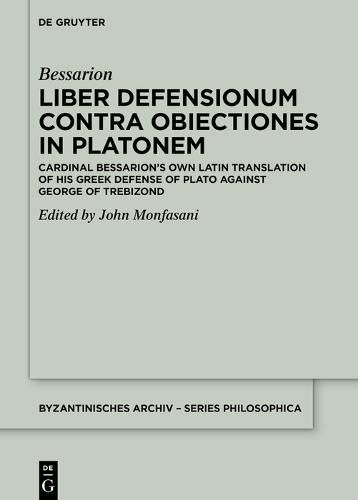Readings Newsletter
Become a Readings Member to make your shopping experience even easier.
Sign in or sign up for free!
You’re not far away from qualifying for FREE standard shipping within Australia
You’ve qualified for FREE standard shipping within Australia
The cart is loading…






This title is printed to order. This book may have been self-published. If so, we cannot guarantee the quality of the content. In the main most books will have gone through the editing process however some may not. We therefore suggest that you be aware of this before ordering this book. If in doubt check either the author or publisher’s details as we are unable to accept any returns unless they are faulty. Please contact us if you have any questions.
In 1458 George of Trebizond transferred the Plato-Aristotle controversy from the Byzantine world to the Latin by publishing his Comparatio Philosophorum Platonis et Aristotelis et Praestantia Aristotelis, a full-scale attack on Plato and the Platonic tradition from antiquity to the present day, ending with a violent diatribe on the dangers posed by the influence of Cardinal Bessarion's recently deceased teacher, George Gemistus Pletho. To respond, Bessarion knew that he would have to do so in Latin, but in actuality, he composed his response in Greek and then translated it into Latin. The result was the Liber Defensionum contra Obiectiones in Platonem, which was ready for publication by 1466. At that point, however, he withdrew it from publication in order to expand its content as well as to refine its Latinity. Bessarion's response finally appeared in 1469 as the In Calumniatorem Platonis. But it was in the Liber Defensionum that Bessarion made his major decisions on what to include as well as what to exclude from his original Greek text and exactly how he would render the Greek into Latin. Thus, to understand the language and structure of the In Calumniatorem Platonis one must turn first to the Liber Defensionum.
$9.00 standard shipping within Australia
FREE standard shipping within Australia for orders over $100.00
Express & International shipping calculated at checkout
This title is printed to order. This book may have been self-published. If so, we cannot guarantee the quality of the content. In the main most books will have gone through the editing process however some may not. We therefore suggest that you be aware of this before ordering this book. If in doubt check either the author or publisher’s details as we are unable to accept any returns unless they are faulty. Please contact us if you have any questions.
In 1458 George of Trebizond transferred the Plato-Aristotle controversy from the Byzantine world to the Latin by publishing his Comparatio Philosophorum Platonis et Aristotelis et Praestantia Aristotelis, a full-scale attack on Plato and the Platonic tradition from antiquity to the present day, ending with a violent diatribe on the dangers posed by the influence of Cardinal Bessarion's recently deceased teacher, George Gemistus Pletho. To respond, Bessarion knew that he would have to do so in Latin, but in actuality, he composed his response in Greek and then translated it into Latin. The result was the Liber Defensionum contra Obiectiones in Platonem, which was ready for publication by 1466. At that point, however, he withdrew it from publication in order to expand its content as well as to refine its Latinity. Bessarion's response finally appeared in 1469 as the In Calumniatorem Platonis. But it was in the Liber Defensionum that Bessarion made his major decisions on what to include as well as what to exclude from his original Greek text and exactly how he would render the Greek into Latin. Thus, to understand the language and structure of the In Calumniatorem Platonis one must turn first to the Liber Defensionum.